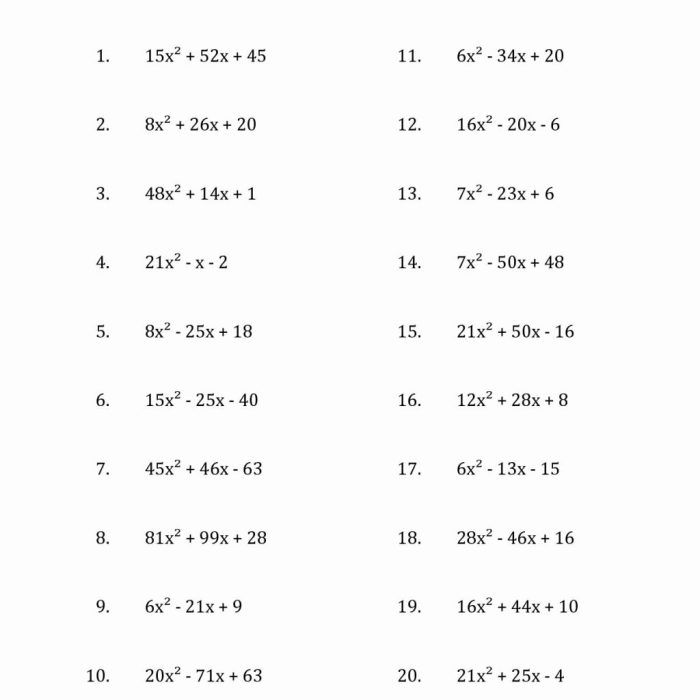Factoring trinomials a 1 answer key – Embarking on the fascinating world of algebra, we delve into the intricacies of factoring trinomials with a1, a fundamental skill that unlocks the doors to solving complex equations and unraveling mathematical mysteries. This comprehensive guide provides a thorough understanding of the concept, its applications, and the various methods involved, empowering you to master this essential technique with confidence.
Throughout this exploration, we will delve into the depths of factoring trinomials with a1, examining its significance in solving real-world problems and its far-reaching implications in various mathematical domains. Join us on this enlightening journey as we unravel the secrets of factoring trinomials, one step at a time.
1. Definition and Overview of Trinomials
A trinomial is a polynomial with three terms. Trinomials are typically written in the form ax 2+ bx + c, where a, b, and c are constants and x is a variable. For example, x 2+ 2x + 1 and 3x 2– 5x + 2 are both trinomials.
2. Factoring Trinomials with a1

Factoring trinomials with a1 involves expressing the trinomial as a product of two binomials. The first step is to find two numbers that add up to b and multiply to ac. Once these numbers are found, the trinomial can be factored as follows:
ax 2+ bx + c = (x + m)(x + n)
where m and n are the two numbers that were found.
Methods for Factoring Trinomials with a1, Factoring trinomials a 1 answer key
There are two main methods for factoring trinomials with a1: the trial-and-error method and the factoring by grouping method.
Trial-and-Error Method:This method involves trying different pairs of numbers until the correct pair is found. The advantage of this method is that it is relatively simple to use. However, the disadvantage is that it can be time-consuming, especially for trinomials with large coefficients.
Factoring by Grouping Method:This method involves grouping the terms of the trinomial in a way that makes it easier to factor. The advantage of this method is that it is more efficient than the trial-and-error method. However, the disadvantage is that it can be more difficult to use, especially for trinomials with large coefficients.
3. Examples of Factoring Trinomials with a1
The following table shows some examples of trinomials with a1 and their factored forms:
| Trinomial | Factored Form |
|---|---|
| x2 + 2x + 1 | (x + 1)(x + 1) |
3x2
|
(3x
|
| 4x2 + 12x + 9 | (2x + 3)(2x + 3) |
4. Applications of Factoring Trinomials with a1
Factoring trinomials with a1 is useful in solving equations. For example, the equation x 2+ 2x + 1 = 0 can be solved by factoring the left-hand side as follows:
x 2+ 2x + 1 = 0
(x + 1)(x + 1) = 0
x + 1 = 0
x = -1
Therefore, the solution to the equation x 2+ 2x + 1 = 0 is x = -1.
Factoring trinomials with a1 is also used in a variety of other mathematical applications, such as finding the zeros of a polynomial, graphing polynomials, and integrating polynomials.
Commonly Asked Questions: Factoring Trinomials A 1 Answer Key
What is the significance of factoring trinomials with a1?
Factoring trinomials with a1 is crucial for solving quadratic equations, simplifying algebraic expressions, and understanding the behavior of polynomials. It provides a foundation for more advanced mathematical concepts and applications.
Can you explain the different methods for factoring trinomials with a1?
There are several methods for factoring trinomials with a1, including the trial-and-error method, the grouping method, and the quadratic formula. Each method has its advantages and disadvantages, and the choice of method depends on the specific trinomial.
How can I improve my skills in factoring trinomials with a1?
Practice is key to mastering factoring trinomials with a1. Regularly solve problems involving trinomial factorization, analyze the steps involved, and seek guidance when needed. With consistent effort, you will develop a strong understanding and proficiency in this technique.
